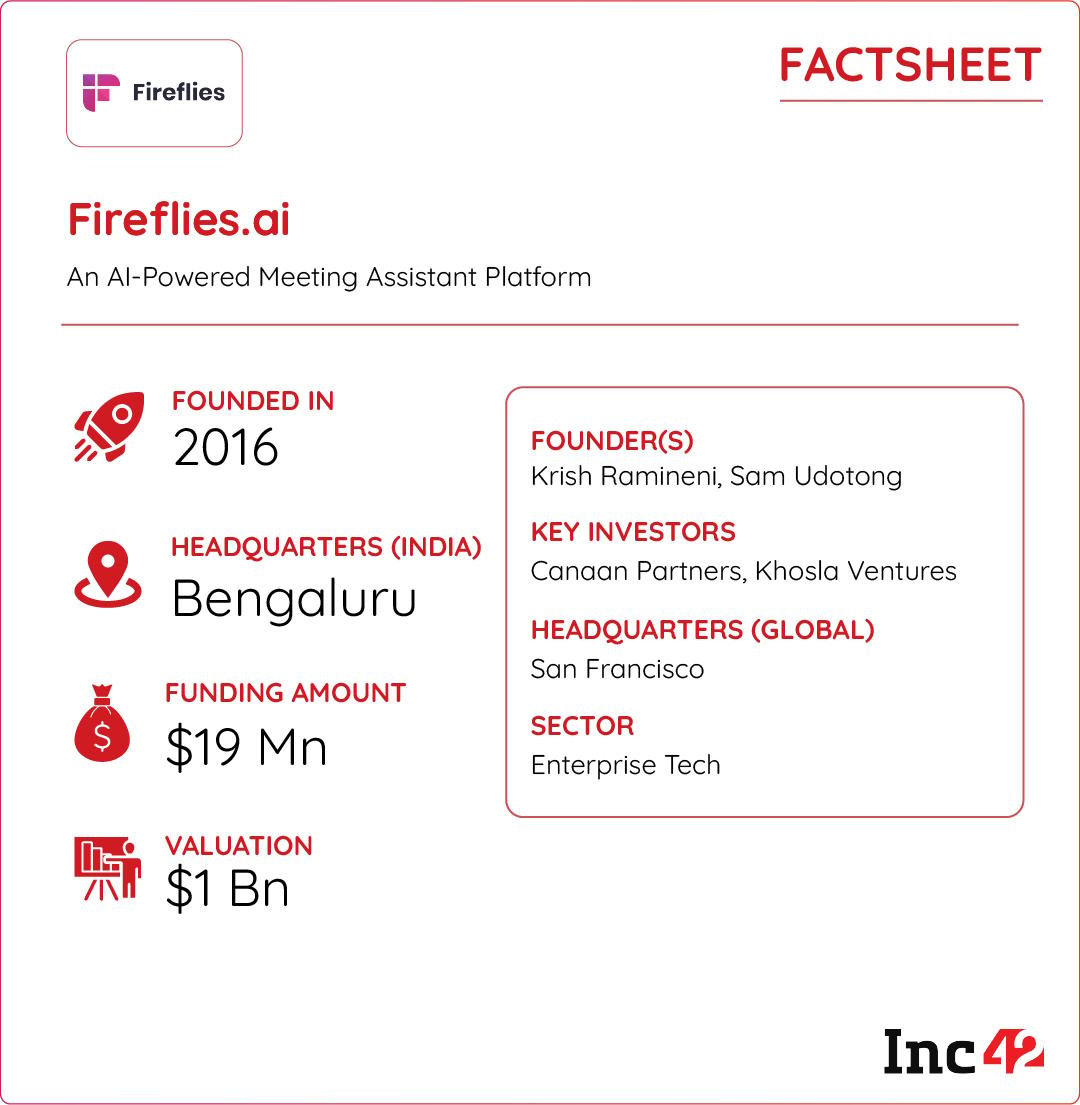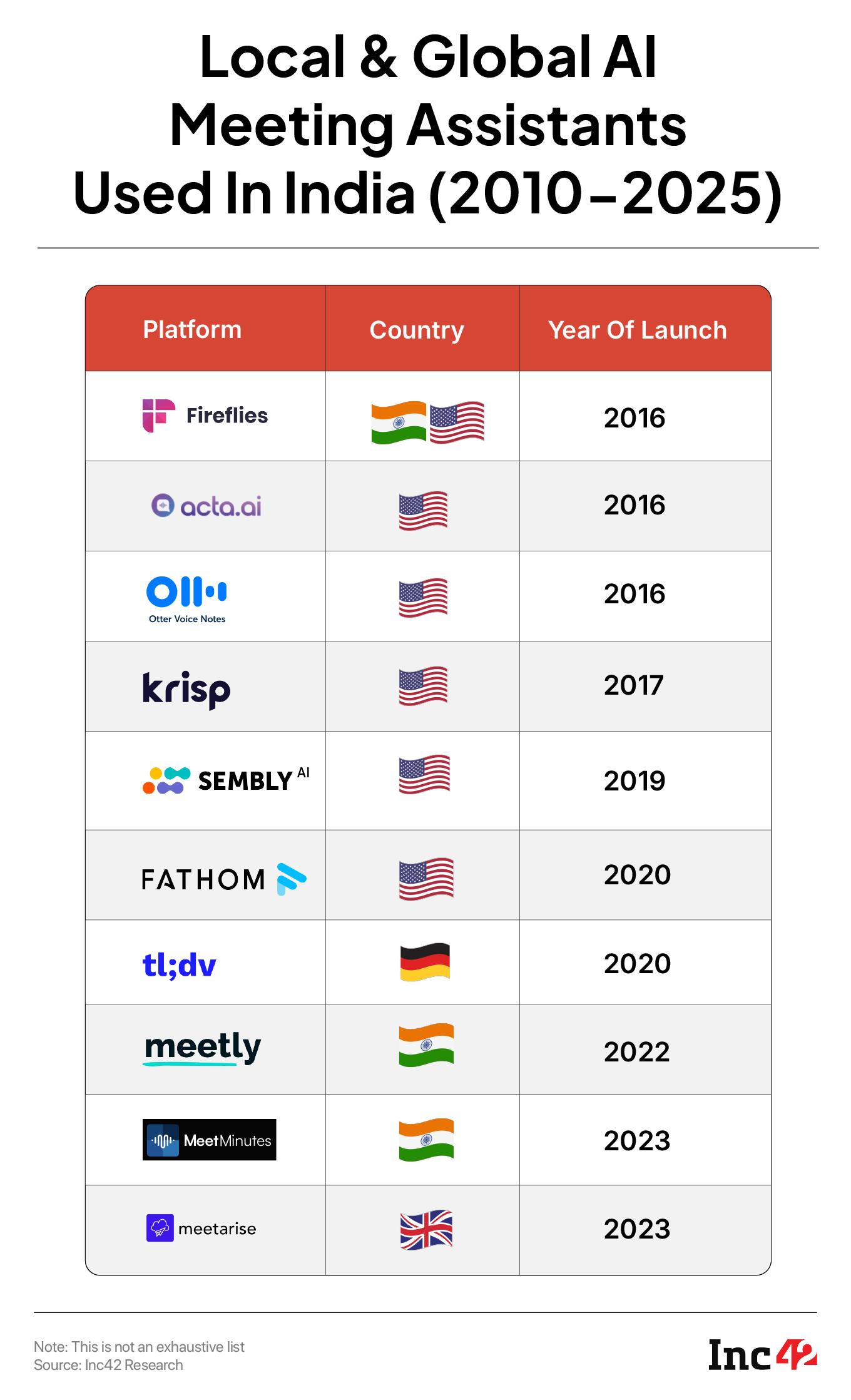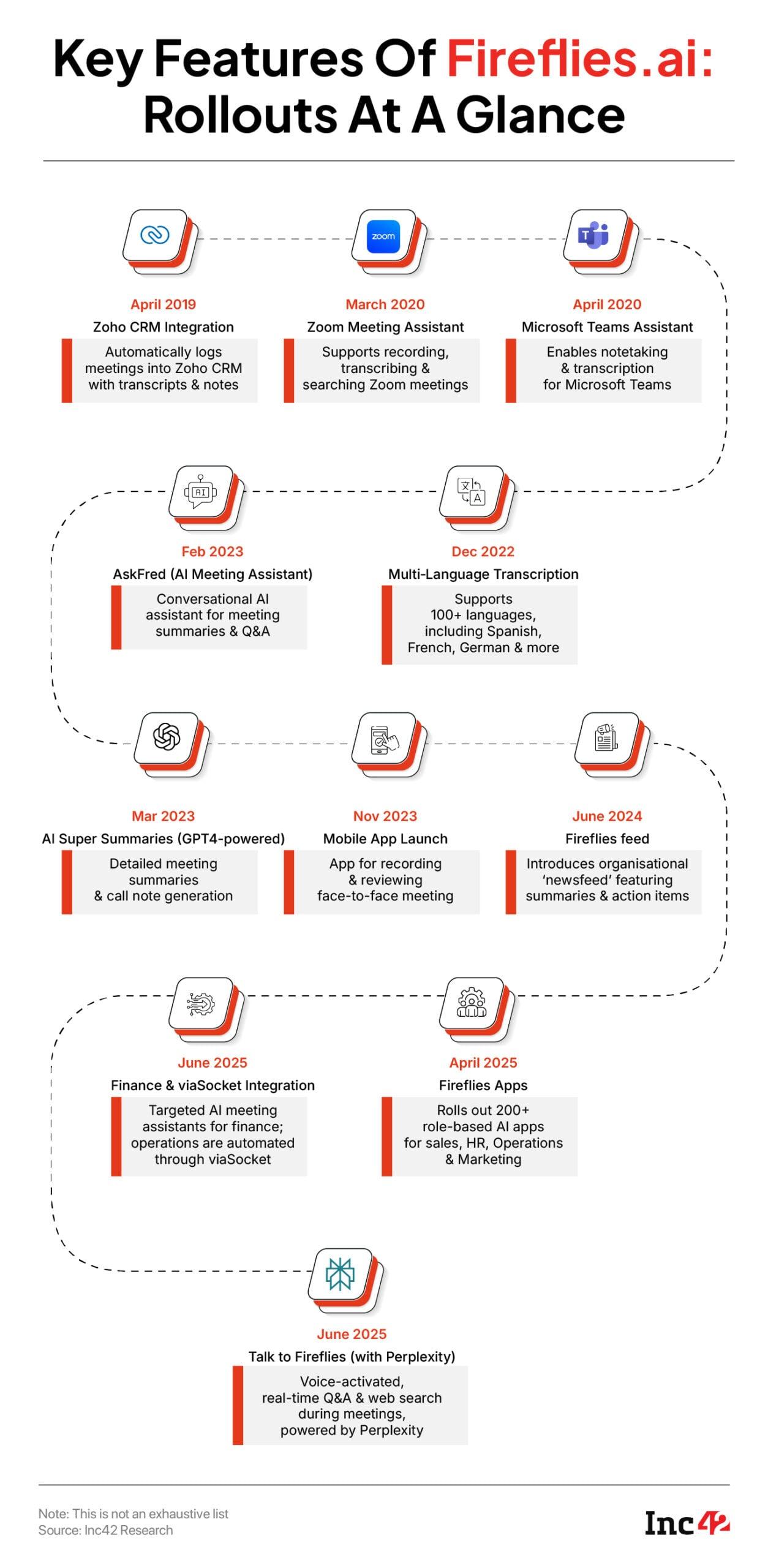In the age of AI-GenAI, technological innovations are not mere tools. They fundamentally change the nature of how our world works. Take, for instance, OpenAI’s all-new ChatGPT-5, which will reportedly go beyond passively waiting for input. It will independently explore and organise tasks, carry out necessary research and get the work done for enterprises and individuals with little human interference. More importantly, it understands context even when a human doesn’t.
Many industry experts feel this comes close to artificial general intelligence (AGI), where AI acquires human-level cognitive capabilities for learning and task execution.
But even a decade ago, technology disruptors (startups, scientists and others) were struggling to develop AI-powered enterprise tools like intelligent meeting assistants to streamline workflows and boost productivity.
GPTs (generative pre-trained transformers) built on large language models (LLMs) were not used to develop chatbots in 2015. For context, LLMs are machine learning subsets where algorithms are trained on large datasets to process, analyse and generate useful content for enterprises and individuals. But in their absence a decade ago, there were no reliable, real-time voice transcriptions and certainly no AI meeting assistants that could understand contexts and accents across industries and conversations.
During the summer break of 2015, Krish Ramineni, a graduate of the University of Pennsylvania and working at Microsoft (he was an Indian-origin student), and Sam Udotong, studying at MIT (Massachusetts Institute of Technology), started tinkering with these ideas. What began as a vacation project turned into a side hustle. Next, it was launched as a startup called Fireflies.ai, which was funded with pocket change ($2K each from the founders).
“I was supposed to go to Cambridge. But Sam asked if I would want to work on something full-time together, and we decided to go in,” founder-CEO Ramineni told Inc42 during an interaction.
At the time, they noticed a widening gap between what meetings produced — scattered, forgotten conversations and information nuggets — and what AI could extract from that input. This became the foundation for Fireflies.ai, a meeting assistant that could turn everyday conversations into searchable, actionable workflows.
“I was intrigued but had just one condition. I didn’t want to be in Boston,” said Ramineni. “So, I said I’d rather split time between India and San Francisco, and the rest is history.”
Launched in 2016, Fireflies.ai started in San Francisco, with its early team based in India. Within nine years, it grew into a widely adopted AI meeting assistant, which was used by 75% of Fortune 500 companies. It supports more than 20 Mn users across 500K+ organisations. In the past 18 months, the platform has experienced an 8x increase in user base, driven by the demand for AI tools that help manage meetings, automate tasks and retain organisational knowledge.
Fireflies.ai claims to have processed over 2 billion meeting minutes to date. The platform offers enterprise-grade security, supports private data storage, and ensures that customer meeting data is not used to train its AI models. Backed by investors like Khosla Ventures and Canaan Partners among others, Fireflies has raised $19 Mn in funding. The company operates as a remote-first team, with 120 employees spread across more than 20 countries.
In June 2025, the startup entered the unicorn club with a $1 Bn valuation, reached via its first tender offer. It is a secondary transaction in which existing shareholders can sell their equity to outside investors at a pre-determined price. In this case, no fresh capital was raised. However, the price ascertained more than $1 Bn valuation, giving its employees liquidity and signalling strong external confidence in the startup without dilution.
Fireflies.ai has been profitable since 2023, a rarity among AI startups, while sustaining triple-digit year-over-year growth without raising primary capital since 2021. Although FY25 numbers are not out yet, its revenue reached $10.9 Mn in FY24, from $5.8 Mn in the previous fiscal year, at 88.1% YoY growth.
Around 20-30% of its employees are located in India, which accounts for 10%-15% of its total revenue. The country’s revenue contribution has grown significantly over the past two years.
The startup supports 14+ regional languages, including Hindi, Tamil and Telugu, which are essential differentiators. Integration with CRM (customer relationship management) tools like Zoho and Freshworks has made the product more compatible with Indian workflows. In addition, mobile application support for in-person meetings, real-time notetaking and accent adaptability have further driven its adoption.
“Three of the five unicorn startups in India see their users leveraging Fireflies.ai within their workflows. I believe it is the most widely used AI meeting assistant in India today,” the CEO said, walking us through the product’s evolution, technical milestones, India strategy and the road ahead.

When the founders started working on the project around 2015, the startup ecosystem in India was slowly gaining momentum. Digital adoption was happening but not at a fast clip. And the emergence of large-scale technology companies was still a few years away. Understandably, artificial intelligence was not yet a mainstream focus. Deployments were limited to basic rule-based systems, mainly in task automation scripts and FAQ bots. And conversational AI, as we know it today, was not in the product portfolio.
While startups and enterprises experimented with the ‘if-then’ logic to automate repetitive workflows, speech recognition remained unreliable, especially across Indian languages, given the regional accents. Natural language processing (NLP) was still in its early stages, often restricted to simple keyword detection.
A handful of early ventures had emerged to address these issues. Haptik was set up in 2013, offering task-based assistance through a human-AI hybrid model. But most others used third-party NLP services like Google’s API.ai (predecessor to Dialogflow) and Microsoft’s LUIS (language understanding) to build structured chat interfaces.
Infrastructure also posed clear constraints at the time. Smartphone penetration was still low; mobile internet was inconsistent, and developer tools for speech/language AI were limited. AI assistants, where they existed, functioned more like rigid automation tools than adaptive systems.
On the other hand, global interest in AI assistants was rising steadily. Apple’s Siri was launched in 2011, bringing renewed attention to voice-based interfaces. In hubs like San Francisco and Boston, startups such as x.ai and Clara Labs (both founded in 2014) prepared to build AI-driven productivity tools, while platforms like Viv Labs (Samsung acquired it in 2016) experimented with deeper conversational understanding.
However, these assistants were built on early neural networks such as RNN (recurrent neural network) and LSTM (long short-form memory, a type of RNN architecture useful for speech recognition, machine translation and more). Hence, they, too, struggled with context, accuracy and scalability.
AI assistants were still undergoing research and experimentation across markets, valued more for their potential than their practical adoption. Fireflies.ai was launched to close this gap.
But before we delve further into its journey, let us look at the key local and global AI meeting assistants active in the Indian ecosystem.

In the early days, Fireflies’ founders did not set out to build a meeting assistant.
“Our initial vision was broader. We wanted to use AI to understand and summarise human communication across email messages, chats and support tickets. The goal was to create a product that could bring to the fore actionable items from conversations, akin to what Google did for search,” said Ramineni.
Because LLMs were not in use then, the startup’s early technology stack relied on NLP powered by in-house models for speech-to-text conversion, sentiment analysis and classification. However, the tech landscape was not mature enough to deliver the ambitious results the founders had imagined.
Faced with dwindling funds and the need for a more practical application, the duo turned to meeting notes, a must-use tool with broad distribution potential. They initially used off-the-shelf applications to build a basic notetaker but gradually replaced third-party components with their proprietary stack as usage grew. In fact, the pivot became the startup’s defining move.
By early 2020, Fireflies.ai was out of beta and ready to operate commercially. Weeks later, the Covid-19 pandemic hit the world, triggering a surge in virtual meetings for years to come. The product, now capable of recording and summarising conversations across platforms like Zoom, Microsoft Teams and Google Meet, saw rapid adoption.
“The pandemic was like an absolute rocket ship accelerator for us. Suddenly, everyone was meeting on those platforms, and Fireflies took off. It became a popular product and an essential tool during those years,” recalled Ramineni.
Other key reasons for its success, even after the pandemic, were the mature technology and the way the viral loops performed.
“It’s kind of what you have seen at Dropbox (seamless and secure storage) or Calendly (online appointment scheduling). Whenever someone saw Fireflies.ai at a meeting, they’d ask about it, get the notes and sign up. That word-of-mouth loop compounded quickly, and the product finally reached a point where it delivered results. Those two years of hard work paid off,” he said.
In 2024, Ramp (then a Series E financial operations platform based in the US) released its quarterly report and listed the most purchased AI SaaS products. OpenAI topped, followed by Anthropic and Midjourney. Fireflies.ai was No. 4 in that list.
How ChatGPT Became A Game Changer For Fireflies.ai“We were amazed to see how many companies had adopted our product. At that point, we led the category featuring AI meeting assistants for teams,” the cofounder added.
Through Khosla Ventures’ network, Ramineni was introduced to Sam Altman, who offered early access to OpenAI’s APIs. Integrating its LLMs marked another step change in Fireflies’ performance.
“We got early access to ChatGPT; well, the OpenAI APIs. It was almost a year before most others did, which carried us into 2023. If Covid gave us a rocket ship liftoff, LLMs gave us double that liftoff.”
Post that, the speech recognition accuracy jumped from 80% to more than 95%, even in noisy environments and across diverse languages and accents. Summarisation evolved from simple snippet extraction to paraphrased, outline-style notes that mimicked human notetaking.
LLMs enabled Fireflies to understand meeting context, identify action points and offer follow-ups, capabilities previously out of reach. Rolling out a mobile app was another practical addition because many people like to document in-person/face-to-face meetings.
Today, Fireflies.ai performs more than 200 different tasks beyond notetaking. It can generate product specifications, memos, candidate evaluations and follow-up email messages. It is often called an ‘AI teammate’ rather than just a notetaker.
“You can query AskFred [the AI meeting assistant] in any language, and it will give you answers based on what was discussed in a meeting. So, you don’t even have to read the notes, go through the transcript, or listen to the audio. We have built strong admin and access controls, with features like channels, where you can make certain meetings private or limit access,” the CEO explained.
Building In-House Vs Plugging In: What Works For Fireflies.ai“Further, all meetings — mine, yours and our teammates’ — are stored in a shared repository or workspace. Everything gets organised and categorised in the Fireflies’ notebook. Therefore, the entire institutional knowledge of a company lives in one place.”
The eternal debate returns, though, when it comes to building features internally versus using third-party APIs from OpenAI or Perplexity. According to Ramineni, what matters most is the clarity of purpose. If it is a core task related to meetings, Fireflies.ai builds it. However, the startup relies on its partners for peripheral requirements like web search.
For instance, Fireflies’ recent partnership with Perplexity allows the former to use Talk. This voice-activated AI meeting assistant provides real-time responses and insights (instantly gathered from external sources) within video calls, with no tab-switching required. Fireflies now combines meeting context with advanced web search, enabling teams to clarify discussions, access information and make faster decisions inside meetings.
The team realised early on that users didn’t only want answers related to their meetings, like: Catch me up on the last 10 minutes, I was late to the call. Instead, people were curious about broader questions, like: When did Fireflies raise its Series A, and what was the amount?
Based on the startup’s partnership with Perplexity, users can raise those queries even during a call, and Fireflies.ai will search the web and respond in real time. In brief, it combines meeting intelligence and web information, enabling seamless in-meeting research without switching tabs.
“We want Fireflies.ai to start pushing work across relevant tools. For example, if we are in a legal meeting and someone asks a law-related question, our meeting assistant can connect with a legal AI and fetch the answer. It will reach out to expert AIs, and those experts can be our partners within our ecosystem,” said Ramineni.
The startup’s architecture has evolved accordingly. The team uses function calling, retrieval-augmented generation (RAG), vector databases, automatic speech recognition (ASR), multiple LLMs and reasoning models, and memory management tools to co-ordinate agents and execute complex tasks. Some processes even involve a chain-of-command architecture where agents can run parallel or multi-step sequences to arrive at the correct answer.
All these may sound intimidating at first. However, all components under the hood focus on capturing data from various sources (even external ones outside the training modules) and producing the most accurate and relevant output.
To power its transition from a passive notetaker to an active decision-support system, Fireflies.ai is working on its underlying architecture to support agentic AI capabilities. When asked how the team co-ordinates these intelligent agents — whether through a centralised planner, modular tools, or memory-based systems — Ramineni broke down the technical foundation driving this shift.
“It comes down to how much data we can ingest. We are using MCP (Model Context Protocol) server with various services. Plus, Fireflies has built its MCP that integrates seamlessly with other tools,” he added.
For context, MCP acts like a universal adapter, allowing AI models, especially those used in assistants and agents, to leverage various resources without custom integration.
What’s more, Fireflies.ai operates in a highly iterative environment. As it caters to millions of users, the team runs rapid experiments and quickly identifies which features will stick. Most product decisions are evaluated within weeks, while feedback loops from its vast user base help determine what stays and what gets shelved.
Security, access control and admin capabilities are also built into the product, which is particularly useful for enterprise customers. Teams can categorise, store and search indexed meeting content within shared workspaces, with configurable permissions and privacy.

AI-GenAI is transforming every sector today. But as their applications differ, so do their revenue and growth potential. In a fast-evolving technology era, no AI enabler can rest on one’s laurels. Even OpenAI, the parent company of ChatGPT, recently rolled out an experimental reasoning model that won a gold medal at the International Mathematical Olympiad. Altman said on X that it is not even a formal math system.
“This is an LLM doing math; it is part of our main push towards general intelligence,” he posted.
Herein lies the crux. With a robust and unified ChatGPT version hitting the market, all AI innovators must focus on ‘autonomous, personalised agents’ which can ‘do’ things for users, smoothly and seamlessly. But this means constantly pushing the frontiers for disruption.
Globally, themarket size of AI-powered meeting assistants is estimated to grow to $7.6 Bn by 2029, rising from $3.2 Bn in 2025 at a CAGR of 24.7%. The growth can be attributed to several factors such as enterprise integration, demand for emotion-aware AI, a rise in personalised meeting experiences, meeting data analytics and the adoption of AI for meeting compliance.
Given this trend, Fireflies.ai is treading the right path, evolving from a notetaker to a utility powerhouse. What began as an email summarisation experiment evolved into a platform helping thousands of businesses turn conversations into actionable outcomes. Amid these, the startup has also remained at the forefront of conversational AI, leveraging LLMs to build foundational NLP.
Despite its many activities and achievements, Fireflies.ai has been capital efficient all along. Its innovations, quality improvements, network effects and economies of scale have contributed to better product performance and greater cost optimisation. For example, between 2021 and 2025, Fireflies.ai slashed its infrastructure and LLM-related expenses by more than 40%, claimed Ramineni.
Becoming a unicorn didn’t involve large marketing budgets or spend-heavy strategies, either. Instead, word-of-mouth and product-led growth did most of the heavy lifting. A strong brand presence also emerged, with mentions in podcasts, LinkedIn posts and workplace conversations.
In the future, Ramineni wants to transform Fireflies into a true AI teammate by delving deeper into agentic AI and real-time pursuit of intelligence. Powered by these innovative features, the startup is not just changing how meetings are documented. It also redefines how decisions are made.
Meanwhile, India remains a key market and core innovation hub in the shift. The CEO is also exploring how to tie up with Indian LLM providers. Such collaborations will deepen localisation efforts and language coverage. Hiring, too, will be a focus area in the country, with plans to grow engineering, design and go-to-market functions.
“I think the country is on the verge of breaking big. And when that happens, we will be the first to line up and partner with all stakeholders,” said Ramineni.
The post Inside Fireflies.ai’s Rise To The AI Unicorn Club And Its Bold India Strategy appeared first on Inc42 Media.
You may also like

Influencer Candace Owens sued by Macrons for claiming France's first lady was born male

England Euro 2025 final opponents confirmed - TV channel, kick-off time, live stream details

EastEnders fans stunned as soap icon returns to TV leaving them 'obsessed'

Transfer news: Chelsea 'reach agreement', Rashford announced, Isak latest

Viktor Gyokeres denied dream Arsenal shirt number but second-choice still available







